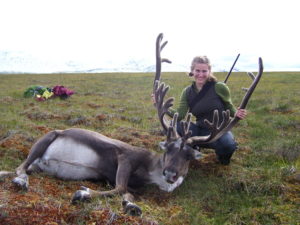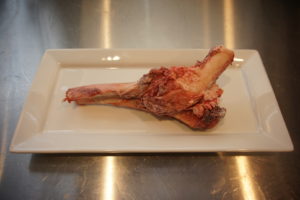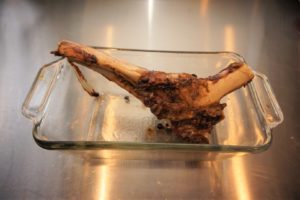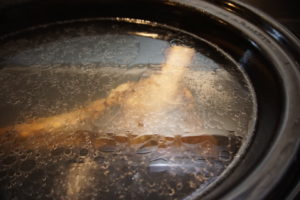How to Make (Caribou) Bone Broth
A Surprising Bone Broth Opportunity…
Sometimes you wake up without any intention of making the best bone broth ever, but then something happens that changes the course of your day for the better.
The other morning, I received a text from my friend, Summer.
“Hey, any chance you can help us butcher two caribou today?”
“I would love to,” I said, “but I have the kids today because Ryan (my husband) is getting ready to go hunting with his dad. If there were someone who could watch the kids, I would be there in a heartbeat… ”
Five minutes later my phone rang. Turns out my friend’s mom would rather watch my young kids than help her daughter cut up dead animals. So, I packed up the kids and headed over to her house.
Rules of Helping a Friend Butcher a Caribou
If a friend (or friends) helps you carry out an animal you have harvested on a hunting trip, it is customary to pay them for their effort with an equal share of the meat. Helping your friend butcher after the hunt is less lucrative, but it’s also a lot less work. Here I have a pack full of meat, about to start the 7 miles back to the truck. Don’t be fooled by the smile, that pack weighed 60-70 pounds. My hunting partner also got a caribou on this trip. The tundra was so hard to walk on, it took two trips and two days to haul the meat back.
The next couple of hours were spent cutting up a caribou with a baby on my back while my three-year-old ran around the garage, turned butcher shop, with my friend’s mom. I would have loved to get a picture of Squishy (that’s what we call our youngest) sleeping on my back at the butchering party, but I didn’t want to touch my phone with my meat-covered hands.
I was paid for my efforts in bones, which I happily took home with me and turned into a delicious broth. Typically, I use bone broth in stews, curries, and for dog food. Since starting to feed broth to my dog, I have seen huge improvements in her shiny coat and nails.
Caribou live in much of Alaska. Several years ago I got this nice caribou in the Arctic circle off the Haul Road. I think Summer was smarter and had her dad flew her in.
Why Consume Bone Broth?
Simply put, bone broth is delicious and is an amazing source of a ton of nutrients! Bone broth is great for your gut, bones, joints, skin…the list goes on and on. Here is a great article by Chris Kesser that highlights the benefits of bone broth if you want to know more.
Wild game bones are the bee’s knees when it comes to bone broth. Because wild game lives in its natural environment and is farther away from environmental pollutants, it contains more nutrients and fewer toxins than any meat you can buy in the store. However, not everyone can head to the tundra to harvest a caribou. Luckily there are plenty of other ways to get high-quality bones.
Sourcing your Bones
Bones are a tissue that bioaccumulates. This means that if the animal is exposed to pesticides, heavy metals, or pollutants, then these toxins will be concentrated in the bones. This is bad news if you don’t source bones from a quality source.
Buy bones that are organic/grass-fed/ pasture-raised if you don’t have access to wild game bones. Your local farmer’s market or butcher shop is a good place to look as well as from organic/grass-fed/pasture-raised cuts of purchased meat that are still on the bone. Not only is meat that has been cooked on the bone full of flavor and nutrients, but it is also typically cheaper. For example, after you roast a whole chicken, you can save the bones for bone broth and really get your money’s worth! If you don’t have the time to go out and find high-quality bones, Butcher Box offers bones as an “add-on” that can be delivered right to your door.
Any bones will work, but bones that include joints result in a broth that is higher in collagen and other healthy-joint compounds. Chicken feet are also great to add if you have them. Ask your butcher to cut the bones down through the joints to increase the surface area. Increasing surface area and exposing the insides will help the water extract all the wonderful nutrients locked inside. It can be intimidating to ask the butcher to do this, but it’s their job and they are usually happy to help. I have found butchers to be a great source of information and very helpful when asked.
Consuming your Bone Broth
I use bone broth any time a savory recipe calls for water. Broth is a must for soups and stews, but I also use it whenever I cook rice to add some nutrition and flavor to a simple bland food. I also use it in my slow-cooker meals. Chilis and curries are my favorites, so that is how my family consumes most of our bone broth. You can also sip broth like a tea. Sipping a cup before bed is a great way to unwind after a long day of butchering caribou and the magnesium and glycine found in bone broth will help you fall asleep!
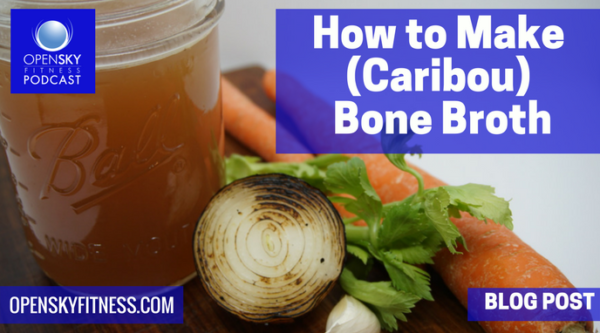
| Servings |
half gallon
|
- 1 pound Bones or more
- Water enough to cover bones by one inch
- 1 splash Apple cider vinegar
- Vegetables, herbs, spices optional
- 1 teaspoon salt per quart
Ingredients
|

|
- Roast at least 1 lb of frozen bones at 425 F for about 20 minutes, until browned.
- Put bones in a slow cooker then fill with filtered water.
- Add a splash of apple cider vinegar, preferably organic, or lemon juice.
- Cook on LOW for 12-24 hours for chicken bones, and 24-36 hours for larger bones, such as beef bones.
- As the bones cook, skim the fat and scum off the top. More often in the beginning, but every few hours throughout (don't worry about it overnight).
- The last couple hours of cooking add organic veggie scraps, herbs, and spices.
- Strain the solids out of broth. It will keep in the fridge about 5 days, adding a teaspoon of salt per quart of broth will help it stay fresh longer. If you aren't going to consume the broth in the next week, freeze it.
How to make (Caribou) Bone Broth
While you may only recently been learning about bone broth and its benefits, bone "broth" is nothing new. Traditional cultures all over the world have been making it for many, many years. Chefs call it stock (and don't cook it long enough, in my opinion) and use it as a crucial ingredient to add flavor and viscosity to soups, stews, and sauces. Here’s how I make my broth.
1. Roast at least 1 lb of frozen bones in a glass baking dish at 425 F for about 20 minutes until browned. The more bones the better, but don't stress over it or put so many bones in that you can't cover them with at least an inch of water when you move them to your slow cooker in the next step. You can generally make more than one batch of broth if you are using bigger bones. I was amazed by how many batches I got out of the caribou bones. Typically, I make one batch for my family, then a second for my dog. With the game bones, I was able to make THREE batches for my family and one for my dog. Well worth the trade with my friend!
Roasting the bones is purely for flavor. Make sure your bones are nice and browned, but not burnt. After baking, liquid may have accumulated in the bottom of your baking dish. If you would like, you can pour this liquid into a heat-proof glass container and let set. Once the fat has risen to the top, discard this and add the remaining liquid to your slow-cooker.
2. Put bones in a slow-cooker and then cover them with water. Make sure if you are using tap water to run it through a filter first. I used this filter before I moved to a house with a well. Cooking with and drinking filtered water or well water is important because the water you use greatly impacts the flavor of whatever your cooking. Unfiltered tap water may also contain things that you don't necessarily want to consume, like excess chlorine which can be hard on the good bacteria found in your gut. I used this filter before we moved to a house with a well.
3. Add a splash of vinegar, preferably organic apple cider vinegar, or you can substitute with lemon juice. Adding acidity allows more nutrients like calcium and magnesium to be released from the bones into your water. Here is a PubMed study to prove it 😉 The study also looked at heavy metals in bone broth. While the study found bone broth to contain safe levels of heavy metals, less is always better. Animals that are fattened up in feedlots can be exposed to more heavy metals. If you source your bone from the right place this is even less of a concern.
4.Cook the bones, water, and vinegar or lemon juice on LOW. If you’re using chicken bones, you will want to cook them for 12-24 hours, and for larger bones like caribou or beef bones, you will want to cook for at least 24-36 hours. As the bones cook, skim the fat and scum off the top. Do it more often in the beginning, and aim for every few hours throughout the cooking process (don't worry about it overnight though). If you skip the skimming, I have found that your broth will taste funky. Trust me on this one. The caribou bone didn't scum up very much, you may see more white foam at the surface of your broth.
Flavoring Your Broth
5.Flavoring the broth is optional, but I like to add herbs and spices as well as organic veggie scraps, skins, stems that I have saved from cooking other dishes throughout the week and stored in my freezer. I don't want to sound like a broken record, but organic is important. Things that are good in broth include, but are not limited to: carrots, celery, mushrooms, onions (and the skins or onion brûlée), herbs, ginger, peppercorns, bay leaves, allspice berries, lemon peel, garlic, etc. Don't be afraid to get creative with the flavorings! If you add the veggies and spices to your broth at the beginning, the long cooking time will overcook them and the resulting broth will be less flavorful, so be patient and wait to add flavorings until the last couple of hours of cook time. You can also leave it plain, which is a fine option if you are going to simply be cooking with it (vs. sipping it alone).
Storing Your Broth
6.You can tell your bones have given you all they can when you can cut them with a butter knife. To store your broth, you will want to strain out the solids. These are the strainers I wish I had. I recommend storing it in glass mason jars (I typically use a quart or a half gallon). Your broth will keep in the fridge about five days, but adding a teaspoon of salt per quart of broth will help it stay fresh longer.
7.If you aren't going to consume the broth in the next week, it freezes really well. You can freeze it in freezer jars. I like to simmer broth on the stove if I am going to freeze it because it reduces the volume by about half, so it takes up less room in the freezer (freezer space is at a premium in our house after hunting and fishing season). After it has reduced I pour it into silicon molds. I like these molds (I actually own two sets) because they are a great individual serving size and they are the same ones I bake personal frittatas in, but that is for another post. Once the broth is frozen I move it to Zip-Lock freezer bags for longer-term storage. When you defrost your broth, just add water to restore your original quantity.
About Gina
Gina Ciolkosz is a Personal Cook and Health Coach living in Anchorage, Alaska. She has a Bachelor’s of Science in Physiology and is an American Council on Exercise certified Health Coach. For the past six years, she has lived in Alaska, where she can’t get enough of the active Alaskan lifestyle that for her includes hunting, fishing, hiking, and the occasional weekend race. She loves to cook for people and enjoys the challenge of making healthy food taste delicious. Open Sky Fitness Podcast was the first podcast she found which helped her realize she wanted to work in the health and wellness industry.
Check her out at Wild and Well Fed and follow her on Instagram
We are a participant in the Amazon Services LLC Associates Program, an affiliate advertising program designed to provide a means for us to earn fees by linking to Amazon.com and affiliated sites


